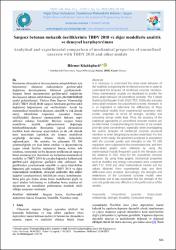| dc.contributor.author | Küçükgöncü, Hürmet | |
| dc.date.accessioned | 2023-09-01T08:18:43Z | |
| dc.date.available | 2023-09-01T08:18:43Z | |
| dc.date.issued | 2023 | en_US |
| dc.identifier.issn | 2564-6605 | |
| dc.identifier.uri | https://doi.org/10.28948/ngumuh.1171778 | |
| dc.identifier.uri | https://hdl.handle.net/20.500.12573/1763 | |
| dc.description.abstract | Betonarme elemanların davranışlarının anlaşılabilmesi için
betonarmeyi oluşturan malzemelerin gerilme-şekil
değiştirme davranışlarının bilinmesi gerekmektedir.
Sargısız beton malzemesinin gerilme-şekil değiştirme
davranışının tahmin edilebilmesi için pek çok matematiksel
model geliştirilmiştir. Türkiye Bina Deprem Yönetmeliği
2018 (TBDY 2018) de de sargısız betonların gerilme-şekil
değiştirme bağıntılarına yer verilmektedir. Ancak bu
matematiksel modellerin dayanım, süneklik ve yük altında
enerji tüketebilme kapasitesi açısından benzer
özelliklerdeki deneysel numunelerden farkının tespit
edilmesi oldukça önemlidir. Böylece sargısız beton
modellerin, analitik yaklaşımlarının doğruluğu
belirlenebilmektedir. Betonarme yapısal elemanların
özellikle kesit davranışı araştırılırken ya da yük altında
kesit tasarımları yapılırken söz konusu modellerin
sergilediği davranışı bilmek büyük kolaylıklar
sağlamaktadır. Bu nedenle, bu çalışmada TS 500
yönetmeliğinde yer alan beton sınıfları ve dayanımlarına
uygun olarak üretilen numuneler basınç testine tabi
tutulmuş, sonrasında ise bu dayanım sınıflarına ait sargısız
beton davranışı için literatürde sık kullanılan matematiksel
modeller ve TBDY 2018 de yer alan bağıntılar kullanılarak
gerilme-şekil değiştirme grafikleri elde edilmiştir. Bu
grafiklerden yararlanılarak süneklik ve enerji tüketebilme
kapasitesi gibi mekanik özellikleri, TBDY 2018 ve diğer
matematiksel modellerle, deneysel verilerden elde edilen
değerler karşılaştırılarak farklılıkları ortaya konulmuştur.
Buna göre göz önüne alınan beton modellerinin güçlü ve
zayıf yönleri belirlenmiş ve kullanılan beton sınıfına ait
dayanımın da modellerin performansı üzerinde etkili
olduğu sonucuna varılmıştır | en_US |
| dc.description.abstract | It is necessary to understand the stress-strain behavior of
the materials composing the reinforced concrete in order to
understand the behavior of reinforced concrete members.
Many mathematical models are developed to predict the
stress-strain behavior of unconfined concrete. The Turkish
Building Earthquake Code 2018 (TEC 2018) also includes
stress-strain relations for unconfined concrete. However, it
is so important to determine the differences of these
mathematical models from experimental specimens with
similar properties in terms of strength, ductility and
consumed energy under load. Thus, the accuracy of the
analytical approaches of unconfined concrete models can
be determined. Comprehending the behavior of the models
provides great convenience, especially when investigating
the section behavior of reinforced concrete structural
members or when designing the section under load. For this
reason, in this study, the specimens produced in accordance
with the concrete grades and strengths in the TS 500
regulation were subjected to the compression test, and then
stress-strain graphs were obtained by using the
mathematical models frequently used in the literature and
the relations in TEC 2018 for the unconfined concrete
behavior. By using these graphs, mechanical properties
such as ductility and energy consumption were compared
with TEC 2018 and other mathematical models and the
values obtained from experimental data and their
differences were revealed. Accordingly, the strengths and
weaknesses of the considered concrete models were
determined and it was concluded that the strength of the
concrete grade was also effective on the performance of the
models. | en_US |
| dc.language.iso | tur | en_US |
| dc.publisher | Niğde Ömer Halisdemir Üniversitesi | en_US |
| dc.relation.isversionof | 10.28948/ngumuh.1171778 | en_US |
| dc.rights | info:eu-repo/semantics/openAccess | en_US |
| dc.subject | Sargısız beton | en_US |
| dc.subject | Gerilme-şekil değiştirme ilişkisi | en_US |
| dc.subject | Dayanım | en_US |
| dc.subject | Süneklik | en_US |
| dc.subject | Tüketilen enerji | en_US |
| dc.subject | Unconfined concrete | en_US |
| dc.subject | Stress-strain relationship | en_US |
| dc.subject | Strength | en_US |
| dc.subject | Ductility | en_US |
| dc.subject | Consumed energy | en_US |
| dc.title | Sargısız betonun mekanik özelliklerinin TBDY 2018 ve diğer modellerle analitik ve deneysel karşılaştırılması | en_US |
| dc.title.alternative | Analytical and experimental comparison of mechanical properties of unconfined concrete with TBDY 2018 and other models | en_US |
| dc.type | article | en_US |
| dc.contributor.department | AGÜ, Mühendislik Fakültesi, İnşaat Mühendisliği Bölümü | en_US |
| dc.contributor.authorID | 0000-0001-5148-8753 | en_US |
| dc.contributor.institutionauthor | Küçükgöncü, Hürmet | |
| dc.identifier.volume | 12 | en_US |
| dc.identifier.issue | 2 | en_US |
| dc.identifier.startpage | 501 | en_US |
| dc.identifier.endpage | 513 | en_US |
| dc.relation.journal | Niğde Ömer Halisdemir Üniversitesi Mühendislik Bilimleri Dergisi | en_US |
| dc.relation.publicationcategory | Makale - Ulusal Hakemli Dergi - Kurum Öğretim Elemanı | en_US |


















